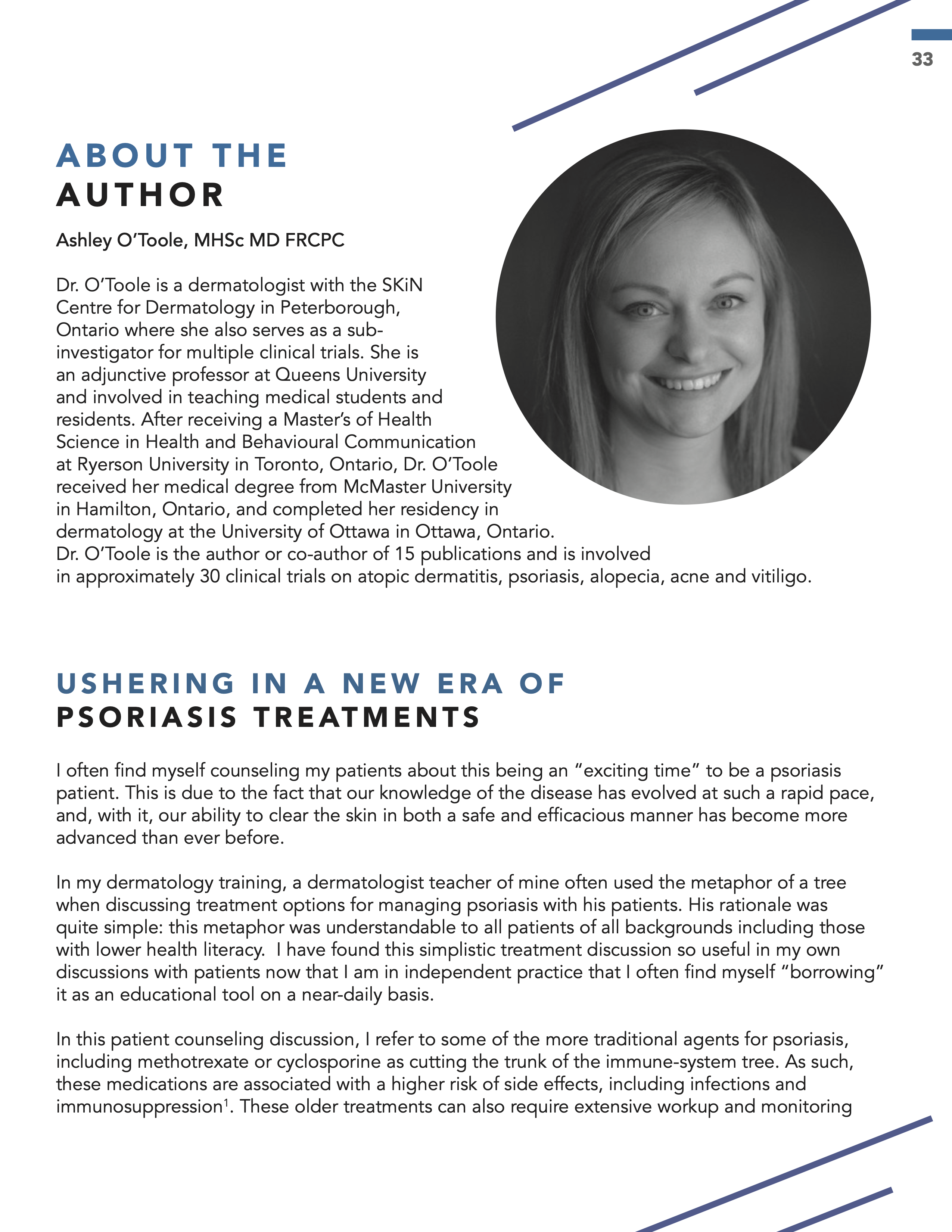Ushering in a New Era of Psoriasis Treatments
Abstract
I often find myself counseling my patients about this being an “exciting time” to be a psoriasis patient. This is due to the fact that our knowledge of the disease has evolved at such a rapid pace, and, with it, our ability to clear the skin in both a safe and efficacious manner has become more advanced than ever before.
In my dermatology training, a dermatologist teacher of mine often used the metaphor of a tree when discussing treatment options for managing psoriasis with his patients. His rationale was quite simple: this metaphor was understandable to all patients of all backgrounds including those with lower health literacy. I have found this simplistic treatment discussion so useful in my own discussions with patients now that I am in independent practice that I often find myself “borrowing” it as an educational tool on a near-daily basis.
In this patient counseling discussion, I refer to some of the more traditional agents for psoriasis, including methotrexate or cyclosporine as cutting the trunk of the immune-system tree. As such, these medications are associated with a higher risk of side effects, including infections and immunosuppression. These older treatments can also require extensive workup and monitoring during treatment. They also often take between six to twelve weeks for optimal onset of action. Unfortunately, by that time, we may often observe a loss of motivation on the part of the patient as they struggle with active disease that does not seem to be effectively managed according to their expectations of the therapy. Additionally, the patient may be lost to follow up before the medication has started to work and this can pose another challenge in the utilization of these older treatments. Patients (and physicians) are often nervous to try these agents which underscores the need for safer and more effective treatment options.
References
Wolverton SE. Major adverse effects from systemic drugs: defining the risks. Curr Probl Dermatol. 1995;7:1-4.
Wolverton SE. Comprehensive dermatologic drug therapy 3rd edition. 2013. Elsevier Saunders Publishing. Toronto.
Mehlis S, Gordon KB. Tumor necrosis factor (TNF) inhibitors. In Comprehensive dermatologic drug therapy 3rd edition. Wolverton (ed). 2013. Elsevier Saunders Publishing. Toronto.
Armstrong AW, Reich K, Foley P, Han C, Song M, Shen YK, You Y, Papp KA. Improvement in Patient-Reported Outcomes (Dermatology Life Quality Index and the Psoriasis Symptoms and Signs Diary) with Guselkumab in Moderate-to-Severe Plaque Psoriasis: Results from the Phase III VOYAGE 1 and VOYAGE 2 Studies. Am J Clin Dermatol. 2019 Feb;20(1):155-164. doi:10.1007/s40257-018-0396-z
Foley P, Gordon K, Griffiths CEM, Wasfi Y, Randazzo B, Song M, Li S, Shen YK, Blauvelt A. Efficacy of Guselkumab Compared With Adalimumab and Placebo for Psoriasis in Specific Body Regions: A Secondary Analysis of 2 Randomized Clinical Trials. JAMA Dermatol. 2018 Jun 1;154(6):676-683. doi:10.1001/jamadermatol.2018.0793
Puig L. PASI90 response: the new standard in therapeutic efficacy for psoriasis. J Eur Acad Dermatol Venereol. 2015;29:645-648.
Blair HA. Secukinumab: A Review in Ankylosing Spondylitis. Drugs. 2019 Mar;79(4):433-443. doi:10.1007/s40265-019-01075-3
Reich K, Sullivan J, Arenberger P, Mrowietz U, Jazayeri S, Augustin M, Parneix A, Regnault P, You R, Milutinovic M. Effect of secukinumab on the clinical activity and disease burden of nail psoriasis: 32-week results from the randomized placebo-controlled TRANSFIGURE trial. Br J Dermatol. 2019 Nov;181(5):954-966. doi:10.1111/bjd.17351
Ryan C, Menter A, Guenther L, Blauvelt A, Bissonnette R, Meeuwis K, Sullivan J, Cather JC, Yosipovitch G, Gottlieb AB10, Merola JF, Callis Duffin K, Fretzin S, Osuntokun OO, Burge R, Naegeli AN, Yang FE, Lin CY, Todd K, Potts Bleakman A; IXORA-Q Study Group. Efficacy and safety of ixekizumab in a randomized, double-blinded, placebo-controlled phase IIIb study of patients with moderate-to-severe genital psoriasis. Br J Dermatol. 2018 Oct;179(4):844-852. doi:10.1111/bjd.16736
Risankizumab Product Monograph available at: https://www.abbvie.ca/content/dam/abbviecorp/ca/en/docs/SKYRIZI_PM_EN.pdf


